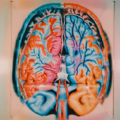I’m lying in my bed, with my arms and legs straight out. I figured out pretty fast that any stress whatsoever on the tendons, makes things worse for days, weeks even. “Stress” includes not only trying to walk or use my arms or legs for any reason at all, but also simply bending my arms, or my knees, or my fingers, in one position for too long. What’s “too long”? Maybe 3-5 minutes or so. I can’t use crutches or a wheelchair, because both of those involve use of my arms and shoulders and hands, which are also out of commission. I can’t type or use the computer, because every tendon in my fingers, hands, wrists, and arms are affected and severely painful. I can’t hold up a book to read, because the weight of the book is too much and I can’t bend my arms, without increasing the tendon pain. The weight of the sheets on my toes causes severe pain in the tendons there. There must be tendons around the eye muscles too, because it hurts simply to move my eyes. So I lay there in my bed, with my arms and legs flat out, with my head still and my eyes closed, waiting. Waiting for what, I’m not sure. It’s hard to believe that I went jogging and bike riding and swimming only a few days ago. I’m also in shock. How in the world could a simple antibiotic that I took for a simple UTI do this to me?
My Journey into the Frustrating World of ADR’s Begins
In March 2010 I took the antibiotic Ciprofloxacin for a simple UTI, and within days became one of the millions of people in this country who experience an Adverse Drug Reaction (ADR) every year to a pharmaceutical drug that is deemed “safe” for use. My adverse reaction, as extreme as it was, unfortunately is not as “rare” as the public is led to believe. It turns out there were tens of thousands of other people, and possibly many times more that, also suffering from the same and similar reactions as I was as a result of this class of very popular antibiotics. There were no “Black Box Warnings” on my drug insert, and the warnings that were listed on the insert didn’t even remotely accurately describe what I was going through then, and continue to go through today.
I’ve been disabled ever since, often times going months without leaving the house, or even getting out of bed, as a result of those few pills. As I lay there waiting, I didn’t know if I was waiting to die or to live. With no known treatment, cure, or detox, or even any idea of why this happens in the first place to some of us, there was nothing left to do but wait. Whatever was known about these reactions came from the victims themselves, observations painstakingly accumulated over time, sharing information that was now available on the internet. Pharma, the FDA, and the medical and pharmacy professions were noticeably and conveniently absent in having any knowledge, concern, clue, or curiosity about these reactions and why this happens in some people, or what to do about it. Their role in all this apparently ended the minute I took the drug.
I’ve had plenty of time to lay around and think about things in the past five years, given that I can’t do much else. And understandably, I’m not too happy about this situation. It didn’t take me too long to figure out that my life, or what was left of it, was simply going to be a nameless, faceless, long lost forgotten statistic when it came to my ADR. There was no help on the way for me from the medical profession, the FDA, or Pharma to help me with my ADR, and as far as I could tell, absolutely no interest in learning anything from it by any of these parties either. And if there was one thing that became quite clear, it’s that everything was skewed in everyone else’s favor but mine when it came to my ADR. My physicians, pharmacists, the FDA, and of course Pharma, didn’t want to even acknowledge my ADR due to culpability and liability issues – which meant none of the numerous physicians I saw even bothered to report my ADR to anyone anywhere or the FDA. Without this acknowledgement, insurance companies didn’t want to pay for any “excessive testing” outside of the basic “Top 40 Diagnoses” screening tests for a non-existent problem. With “nothing wrong” on paper, I was denied any form of disability payments and probably considered to be a hypochondriac and/or malingerer trying to commit disability fraud. Even the legal profession, as hungry as they are for business, wasn’t interested in me once they found out I took the generic, since there is no legal recourse available with generic drugs. Everyone else in this chain of events walked away from my ADR unscathed, except, of course, me. I’m the one stuck living with it every minute of every day, with no assistance, and no end in sight. I’m the one scouring the internet, reading everything I can about my symptoms, reviewing the available research, paying for my own medical testing, looking for something, anything that will give a clue as to what this drug did to me and how to fix it.
The only other thing I can say about this scenario is that I’m actually not alone in my frustration and anger about this. There are millions of people out there who have been harmed by a pharmaceutical drug, vaccine, or medical device, in the same boat I am. Most of us have felt this same sense of abandonment by “the system”. Each one of us does the best we can, trying to figure out how to pick up the pieces of a life destroyed by a pharmaceutical prescribed to us by the medical profession, and deemed “safe” for use by Pharma and the FDA.
We’re All Sitting Ducks, Sacrificial Lambs, and Play Russian Roulette When it Comes to ADR’s
Several issues have become quite clear to me since I got hit with my ADR. First, is that for the most part, everyone, from Pharma to physicians and pharmacists, to end consumers like you and me, accept that ADR’s are a part of the deal. A lot of rules and regulations are in place in a supposed effort to ensure that a pharmaceutical is safe for “most” of the population. And therein lies the unspoken fact. At the end of the day, no matter how much effort has been put into safety, it’s accepted that there will always be some people that will react negatively to a drug. There’s an implicit acceptance, regardless of how unpalatable it might be, that “some always have to be sacrificed for the greater good”. We just hope that sacrificial lamb won’t be us or those we love.
Secondly, is that pharmaceutical use, and their ADR’s, are here to stay. In the US, nearly 70% of the population is on one prescription drug, more than 50% are on two, and 20% are actually on five or more prescription medications. Between 1990 and 2008, U.S. spending on prescription drugs increased from $40 billion to $234 billion. And this doesn’t even include all the over the counter meds. As a society, “Just Say No” has never worked for any drug, and that includes legal pharmaceuticals. Increasing right along with this pharmaceutical epidemic, are the “serious and fatal event” ADR’s, which have quadrupled in the past decade, even by the woefully inaccurate and under reported FDA records. Every single person reading this is at risk for experiencing one or more ADR’s in their lifetime. These ADR’s may be mild and transient, or severe, disabling, and long term or lifelong. They might even be those “fatal events” the fast talking monologues on the drug commercials always warn you about. The point is, no one reading this is safe or exempt from them. Even people who are very “anti-Pharma” may find themselves on the operating table in the ER someday, being given any number of pharmaceuticals without the opportunity for “informed consent”. We are all at risk, and basically sitting ducks when it comes to ADR’s. I rarely took any medications or supplements, and had only taken antibiotics a few times in the first 50 years of my life. Despite that, I let my guard down once — it only took a few pills, and there was no going back from that mistake. I read the drug insert carefully, which talked about how a little transient mild nausea or GI upset might be the worst ADR, and further on down, mentioned “if you develop a pain in your Achilles tendon, call your doctor”. There was no hint in these warnings that these symptoms could be so extreme, permanent, disabling, and that “my doctor” had never heard of it and had no clue what to do about it either.
Third, is that pharmaceutical companies of course want to minimize, downplay, and outright deny ADR’s because they don’t want to open themselves up to culpability and liability issues and lose profits. From the limited “safety studies” that Pharma does on a drug pre-market, to “publishing bias” of only publishing research studies with data in their favor, to minimizing and hiding the adverse effects as they sell their products to the medical profession and us, Pharma does all they can to get a drug to market and profit from it. Once the drug gets to market, the big experiment occurs, as the drug is unleashed en masse on the general population. For those taking the drug, it’s essentially a game of Russian Roulette, no matter how “informed” you are. At that point in time, if things go wrong, it usually takes tens of thousands, hundreds of thousands, or millions of people suffering severe ADR’s before any action, if any, is taken (think Thalidomide, DES, and more recently, Vioxx). YOUR life may be wrecked, but it’s no big deal to Pharma, the FDA, or even your doctors. If you experience a severe ADR, their lives will continue on, while your life becomes just another long lost statistic, simply considered the “cost of doing business”.
Pharma: The Untouchable Behemoth
It can seem pretty hopeless at times. Physicians and pharmacists get their extremely biased information on the drugs they prescribe directly from Pharma via Pharmaceutical Sales Representatives. These reps get more training in marketing and selling, than in knowing anything about the products they’re selling. If the more curious and ethical physicians actually do take the time to look up the research, they will see biased research studies funded by Pharma, all minimizing the risks while highlighting the benefits. The FDA, who relies on Pharma to do the research studies and present the findings on safety and efficacy of drugs, as well as relies on Pharma as a large source of funding for their own organization, is equally in the dark and basically impotent, as they now see Pharma as their main client to serve, and not the public. And we, the people? We’re the sacrificial lambs, the sitting ducks, and the true massive post surveillant “research study” when we play Russian Roulette with safety and efficacy of any drug Pharma puts out. The icing on the cake for Pharma is that they can laugh all the way to the bank, no matter how many people are harmed, in the meantime. If, despite Pharma’s best attempts, a drug indeed is found to be unsafe, their main goal is to sell the hell out of it to keep bringing in profits until they are absolutely and overwhelmingly forced to remove it from the market.
This is nothing really new. If you live long enough, or read history, you will see the same old story over and over again, whether in the pharmaceutical industry or any other industry. And if you think your doctor or the medical profession is any smarter than the rest of us, think again. As I discussed here, in another writing:
“My own mother was “prescribed” cigarettes – yes, that’s right – as part of her “prenatal care”, she was told to start smoking by her doctor while pregnant with my younger sister “to prevent hemorrhoids”. We can laugh, or be aghast now at such a notion, but an entire generation, including the medical profession at the time, was repeatedly brainwashed by the corporations manufacturing these products, and they would leave no stone unturned in promoting the “health and safety” of their products for the sole interest of their own profits.” (See: here, and here. And for anyone wondering, the ‘science’ behind this is that nicotine constricts blood vessels. And yes, this is exactly how my mother started smoking at age 32).
I provide this example simply to highlight the fact that medical professionals are subject to the same corporate and cultural forces that we all are. Drugs that would never be blithely and indiscriminately prescribed today, such as Thalidomide, DES, Vioxx, and many others were routinely prescribed by physicians in the not too distant past, and this apparently includes “cigarettes” as well. The point being, is the drug your doctor prescribing you today the result of a judicious, prudent, and well thought out approach deemed absolutely necessary for your health? Or is it simply the latest fad promoted by Pharma, the next big blockbuster drug for their coffers, being offered you even when safer, less expensive, or better alternatives may exist?
“Your doctor” is subject to the same forces everyone else is, and they happen to be a very important target for Pharma in particular. Most physicians are honorable, trying to do the best they can with the information they have, but the fact is, they might not know any more than you do if what they’re selling (prescribing) you is a necessary and lifesaving drug, or a ‘cigarette’ of a drug. It turns out, when it came to my particular ADR, plenty of medical professionals have been hit and suffer from the same ADR’s. I sure wish I had known that before I took the drug, because now I’m one of them.
The odds are overwhelmingly in Pharma’s favor and against us. And despite everything I’ve written, I’m not really “anti-pharmaceutical”. I’m well aware pharmaceuticals and modern medicine have helped and saved many lives. I happen to love both science and medicine, and I’m a big believer in using the fruits of ethical, curiosity-driven science and medicine in its truest, most honorable and noble form — to improve the health and welfare of individuals and society as a whole. The problem is, that’s not a description of current day Pharma. Phrases more apt to come to mind with the word “Pharma” now include: Corporate Greed, Profits at All Costs, America’s legal Drug Cartel, White Collar Drug Dealers, and “Pharmageddon”. The medical profession is allowing themselves to be reduced to Pharma’s “drug pushers”, pushing pills for everything and everybody even if they’re not necessary or downright dangerous, with drugs as the first and sole option offered even when other options such as healthy lifestyle changes can help.
Given these odds, is there anything we can do to protect ourselves? Is there anything we can do to demand change?
We Need Your Help
More people than ever are reading Hormones Matter, a testament to the need for independent voices in health and medicine. We are not funded and accept limited advertising. Unlike many health sites, we don’t force you to purchase a subscription. We believe health information should be open to all. If you read Hormones Matter, like it, please help support it. Contribute now.
Yes, I would like to support Hormones Matter.
Share Your Story
If you have suffered from a medication or vaccine adverse reaction, please share your story.
Photo by Jessica Tan on Unsplash
This article was first published on June 8, 2015.
























